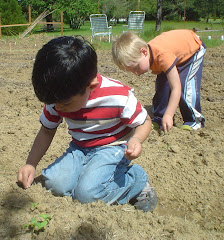 |
| Chris gives a lesson in seed-planting - 2015. |
Well, we've come through a
wet, grey January
with a couple of really cold spells but it seems that spring is finally
on its way. We decided to take a break from bringing Oregon State Univ.
students to the gardens for winter term. Chris and I are largely caught
up on major building projects and tree-planting and we didn't feel we
had enough projects that needed student help. Six students can get a lot
done in four hours! But we've already got lists started for the spring
and hope to host at least two OSU groups.
"Anyone
who thinks gardening begins in the spring and ends in the fall is
missing the best part of the whole year; for gardening begins in January
with the dream." - Josephine Nuese
 |
| Adri fills pots with soil. |
Being the gardeners that we are, we just couldn't
wait to get some seeds started. This post is about our continued
experiments with creating fertile soil using locally-sourced materials
and the seeds we've started (including some links to earlier posts on
how to grow some of the plants listed below).
Soil-prep: (Growing
food using "organic" methods is a very dynamic and ever-evolving
process. What follows are the techniques we are currently using but we
won't necessarily know if we are successful until crops come to harvest.
Also, a method that works one year under certain climate conditions may
not be successful in years to come).
 |
| Chris adds and mixes in compost. |
Because we're slowly weaning ourselves
from using the rototiller to loosen soil (outside) and creating
permanent beds (in the greenhouses) much of winter "gardening" involves
preparing beds for spring planting.
Greenhouse Prep:
In the Fall we pulled old plant material from the beds and gave them a
light sprinkling of wood-ashes and a thicker coating of coffee grounds.
The ashes provide many needed minerals. The coffee-grounds also boost
the nutrient-content of the soil but the main reason we like to use them
is that they are a favorite food for worms. With this food source, they
reproduce rapidly and add their worm-poo (castings) to the soil which
is an almost perfectly balanced fertilizer! In the Fall we also covered
the beds (and paths) with a thick mulch (leaves, straw and fresh
grass-clippings).
 |
| Llyn adds more coffee grounds. |
In late January we began to we pull all the mulch off
the beds and add it to the paths. It will continue to compost through
the spring and summer and, as plant-roots grow out into the paths, they
will be nourished by this material.
Once the beds were cleared, we added
more
coffee and compost, and gently dug it in a few inches. We've been
absolutely amazed with how much worm activity we're finding in our
greenhouse beds!
It's good to have several weeks with
the bare soil exposed as the sun's heat will warm it and activate many
micro-organisms. The added coffee also encourages worm-reproduction
which adds more nutrients and worm-tunnels to the soil.
LINK: Preparing Garden Beds - One Low-tech Way
 |
| We
put the first batches of seeds on electric heat-mats with plastic
covers to keep in heat and moisture. This gives a head-start to seed
germination. For later batches of seeds, when there is more sun to heat
up the soil, we won't use the mats. |
 |
| This is what the greenhouse will look like in a short time! |
Here is a list of the seeds we've started in pots, in the greenhouses:
 |
| Peas back-lit by the sun. |
We started peas at the New Year but it was too cloudy
and cold for the seeds to germinate (many rotted in the pots) so we
re-planted mid-January. The peas are mostly up about an inch now. When
they're 4"-5" tall they'll be transplanted into greenhouse beds.
 |
| Cindy with carrots - 2016. |
As an experiment, we've started
a small patch of carrots and beets in a greenhouse (they prefer cooler
soil to germinate). Ideally, they'll be done producing by mid to
late-spring leaving room in the beds for summer-crops such as tomatoes
and peppers that love the heat!
LINK: Tips for Planting Carrots
 |
| Burgundy Globe onions-an Heirloom variety from which you can save seed. |
Onions: We like to start onions from seed as
it is less expensive than buying "sets" and we have less incidents of
onions "bolting" (going to seed) which means that we have a bigger
harvest. Here is a
LINK to a post about growing onions from seed.
 |
| Lettuce! Can't you just taste that tender goodness? |
Lettuce: Our goal this year, is to start small
batches of lettuce every few weeks until it gets too hot to grow it (it
prefers the cooler spring and fall weather). This way we can have
enough for everyone who helps with the gardens and to share with the
South Benton Food Pantry and
Local Aid.
LINK: Growing Lettuce from Seed.
 |
| Red Winter Kale - one of the most nutritious land-vegetables! |
Kale: We have a few plants that wintered-over
outside this year. We'll eat most of these spring "greens" (so sweet and
tender after getting a "kiss" of frost). Kale-flowers, formed in their
second year, also called
raab, are also delicious and nutritious.
We'll eat some of the flowers and let some of it go to seed so we have
enough seed for next year.
 |
| Llyn with Broccoli-2009 |
Broccoli: We're experimenting with growing
some of our broccoli crop in the greenhouse this year. It doesn't like a
lot of heat but we hope to have it done and harvested by late-spring
when the heat begins to build.
 |
| We use milk-cartons or large soy-milk containers as collars. |
Celery: Celery takes a very long time to grow,
especially at first. Once it establishes a long and extensive root
system, the upper part grows more rapidly. Commercially-grown celery is
one of the more highly-pesticided crops so it's good to grow your own or
buy "organic".
The collars - pictured above - provide
pest-protection, cause the celery to grow up-right and "blanch" the
stalks so they are more tender.
 |
| These potatoes, with their short, stout sprouts, are ready for planting. |
Potatoes: Each year we try new methods to grow
potatoes. Potatoes have a natural dormancy period and will begin to
sprout once this period is over. They need to be planted within a month
or so of sprouting or they will begin to shrivel and won't be as viable.
We have a lot of clay in our soil and it can stay cold and wet until
late spring. Many times we have had our seed-potatoes rot in the ground
before the last of the spring rains drain. This year we are going to
plant two rounds of potatoes; a first crop inside the greenhouse and a
second one outdoors in late spring. This later batch will provide
storage potatoes and perhaps even seed-potatoes for next spring. Here is
a
LINK to a post on
preparing potatoes for planting.
 |
| Re-potting a tomato seedling. |
Tomatoes: It's always a tricky dance to start
seeds early enough to have the longest growing season but not so early
that you have to keep transplanting the 'starts' into larger pots until
it's time to put them in the ground - using your precious time and
potting soil. For the second year in a row we will plant all 90 (or so)
tomato plants
inside greenhouses so we started our first batch of
seedlings in early February. Later we'll start more tomato seeds that
we can share with people in our community.
Saving Seeds:
We save and re-plant over 85% of our own seeds. Developing this skill
is fun and very rewarding. The seeds you save yourself will be adapted
to your own micro-climate and soil conditions. One of the advantages of
having a community-garden organized like the Sharing Gardens (with all
of us growing food together; no separate plots rented by individuals and
families) is that you can coordinate seed-saving and isolate varieties
that might 'cross' and give you impure seed.
LINK to saving your own seeds
 |
| Chervena
Chuska peppers. If peppers are pulled up in the Fall before the first
frost, and hung indoors, they will continue to ripen on the plant. |
Peppers: Like the tomatoes, we finally have
enough indoor greenhouse space (2500 square feet) to grow most of our
peppers. This extends our season for growing by at least a month. These
heat-loving plants require warm soil to germinate so, when starting the
seeds (even in a greenhouse) we put them on an electric heat-mat. Our
seeds typically break through the soil in 8-10 days.
 |
| Chris has been painting a new sign for the Food Pantry. |
Winter's not over yet!
Though the days are growing longer and signs of spring are all around,
there's still plenty of time for creative projects, baking and other
activities that must retreat to the background in the height of the
garden-season.
 |
| ...and Llyn's been having fun in the kitchen baking pies and bread and muffins! |
The Sharing Gardens is located in the southern Willamette Valley of
Oregon and is considered Zone 7b by the USDA.
Click here
to find your
gardening zone. To find a planting guide for your area, do a search
on-line. Most agricultural universities offer guides specific to their
regions.























































